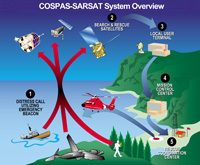SARSAT Makes 6,000th Rescue in the United States
October 31, 2008

COSPAS-SARSAT System Overview.
High resolution (Credit: NOAA)
Two people rescued from the site of their downed airplane near Concrete, Wash., pushed to 6,000 the number of people rescued in the United States by the system that uses NOAA weather and climate satellites to pinpoint downed pilots, shipwrecked mariners, and stranded hikers. The plane’s pilot did not survive the accident.
NOAA’s operational polar-orbiting and geostationary satellites pick up distress signals from emergency locator beacons and relay them to Search and Rescue authorities. Since 1982, the Search and Rescue Satellite-Aided Tracking system called, COSPAS-SARSAT has been credited with supporting more than 25,000 rescues worldwide.
“With an average of more than 250 rescues each year in the United States alone it’s clear this system is a valuable tool in saving lives,” said Chris O’Connors, program manager for NOAA-SARSAT. “This milestone also comes four months before SARSAT begins tracking distress signals exclusively from the 406 MHz frequency.”
Older emergency beacons, which operate on the 121.5 and 243 MHz frequencies, will be phased out by February 1, 2009. That’s when the 406 MHz will become the new standard. Key reasons for the switchover include the ability of the 406 MHz beacons to be detected instantly and provide for global coverage.
The newer beacons are also more accurate and provide Search and Rescue responders with important registration information from the owner – features the older beacons do not offer.
“We’re encouraging all 121.5 MHz beacon owners to make the switch now to the 406, so their distress signals will always be heard.” said NOAA Corps Lt. Jeffrey Shoup, adding that the 6,000th rescue involved an older 121.5 MHz beacon.
When a satellite pinpoints a distress location within the United States, or its surrounding waters, the information is relayed to the SARSAT Mission Control Center, located at NOAA’s Satellite Operations Facility in Suitland, Md. The distress signal information is then sent to a Rescue Coordination Center, operated either by the U.S. Air Force – for inland rescues, or the U.S. Coast Guard – for maritime rescues.
In 26 years, COSPAS-SARSAT has seen growth. The four original member nations (Canada, France, Russia, and the United States) have been joined by 36 other nations that operate 66 ground stations and 29 mission control centers worldwide or serve as search and rescue points of contact. The system continues to be a model of international cooperation. During the 1980s, the Soviet Union and the United States were able to put aside their Cold War differences and tackle tough technical issues. Today, as new technology evolves, the member nations incorporate that technology into the system.NOAA understands and predicts changes in the Earth's environment, from the depths of the ocean to the surface of the sun, and conserves and manages our coastal and marine resources.
